There’s only so much you can do with iron sights. I’ve seen people hit the 10 ring from 1,000 yards away using nothing but a M-16 with aperture sights, but what if you’re not on a flat range with a gigantic black dot as your target? What if you need to hit a deer at distance, or a small metal plate? What about if you absolutely cannot miss and lives are on the line? For those who need to make precision shots from long distances and actually see what they’re hitting Leupold has developed the Mark 4 riflescope, and I got my hands on one to test out.
My first impression of this scope was that it is MASSIVE compared to every other piece of glass I own. The thing weighs 22.5 ounces, almost double the weight of the Trijicon Accupoint I have on my competition rifle. That extra weight really is noticeable on a firearm, and putting a scope like this on a firearm basically restricts it to being the precision equivalent of a crew served weapon — you set it up somewhere and then don’t move it a lot. Which works, because you can see for MILES with this thing.
And now I can’t get The Who out of my head. Moving on…
There are a number of features I really like about this scope, some I could do without, and one specific feature that is slightly infuriating. Let’s start with the good stuff, shall we?
The best part about this scope is the magnification of the target it provides. The highest power scope I personally own is a 9x magnification, but this one STARTS at 8.5x and goes all the way to 25x. That’s about enough magnification to see the holes you’re putting in the target from 600 yards out, useful if you don’t want to lug a spotting scope out to the range along with this boat anchor. It also helps if you’re shooting small targets from extreme distances because the first requirement in hitting a target is being able to actually see it.
With increased magnification comes a dimmer sight picture and a shallower “depth of field,” which brings me to reason #2 I like this scope — the adjustable parallax.
If you don’t understand how parallax screws up your shots I have a convenient article about that right here which I recommend you take a peek at. In short, if you don’t have it adjusted properly you could find your group sizes suffering greatly. The parallax adjustment knob (left side) allows you to quickly fine tune the focus of the scope and make sure you’re eliminating as much parallax as possible between the reticle and target.
There’s tons of other features that are nifty and useful, such as flip-up lens covers (included at no additional cost), knobby adjustment knobs, and clear directional markings to tell you which way you turn the knob to make your bullet go up or down. But there are a couple things that I didn’t exactly appreciate.
The reticle on this bad boy is a “mil dot” crosshair. The distance between each dot is supposed to be exactly one “milliradian,” or about .001 radian. Like minutes of angle (MoA), milliradians provide a method of identifying and quantifying the angle made by the point of impact (POI) relative to the point of aim (POA) of the scope. Or something like that. The point is that MIL and MoA are different measurements and not interchangeable.
This becomes a problem when the reticle is set up using MIL and the adjustments for the scope are in MoA. In an ideal world you should be able to look down the scope, count the distance between POI and POA using the markings, and adjust accordingly. When the scope is set up using both MoA and MIL you either need to convert from one to the other using a calculator or simply guess and adjust. It’s not as fast, but once the scope is dialed in you can still use the scope markings to adjust your hold for elevation and windage on the fly depending on the conditions.
MIL dots would still be slightly useful (despite the MoA adjustments) if the reticle was in the right focal plane. Which it isn’t. The reticle on this scope is in the second focal plane, which means that it stays a constant size relative to the shooter’s perspective while the target gets larger. This is an issue because it means that the MIL dots are practically useless unless you set the scope to the “proper” power, and if you never change the zoom on the scope then you’re not really getting your money’s worth out of it. And that is slightly infuriating.
I get the feeling that the reason for the second focal plane reticle is so Leupold could add their funky illumination to the reticle and make it light up. I never understood the appeal of an illuminated reticle, but then again I’ve never tried to shoot anything before dawn or around dusk and never intend to. Maybe it helps, maybe it doesn’t. All I know is that I could live without it.
That seems to be the recurring theme — it’s nice but I could live without it. It’s a fine scope that has some great magnification, but for me the bells and whistles ruin it instead of enhancing it. I don’t need an illuminated reticle or MIL dot crosshairs or anything like that, I just need something that shows me where I’m aiming and makes the target look bigger. Sometimes the simpler solution is the better one.
Specifications: Mark 4 8.5-25x50mm LR/T M1 Illum. Reticle
Weight: 22.5 oz.
Length: 14.4″
Adjustments: 1/4 MoA
Eye Relief: 3.7″
Tube: 30mm
MSRP: $1,600
Ratings (out of five)
All ratings are relative to similar products, final rating is not mathematically derived from the preceding ratings.
Optical Clarity * * * *
Fairly sharp picture approaching the quality of a Swarovski Optik scope, but not quite.
Feel & Function * * * * *
The scope functions just fine. Clicks seem to be 1/4 MoA, and it holds zero OK.
Overall Quality * * * * *
The build quality of this scope is fantastic. The exterior is sleek and polished with intuitive controls that are easy and ergonomic to adjust.
Overall Rating * * *
For $1,400+ I expected the scope to at least be a first focal plane reticle. Like I said, the bells and whistles ruined it for me. The magnification is great, the optical quality is great, and the scope holds zero like a champ, but it just seems “meh” overall to me when you take into account the price, the usefulness of the features and the weight.
FYI, for $100 more you can get a scope that fixes all of these issues — a Leupold Mark 4 ER/T 8.5-25×50 M5 Front Focal TMR. That would easily soar into the four star range, assuming everything is the same quality as this scope. MILs just take time to understand.

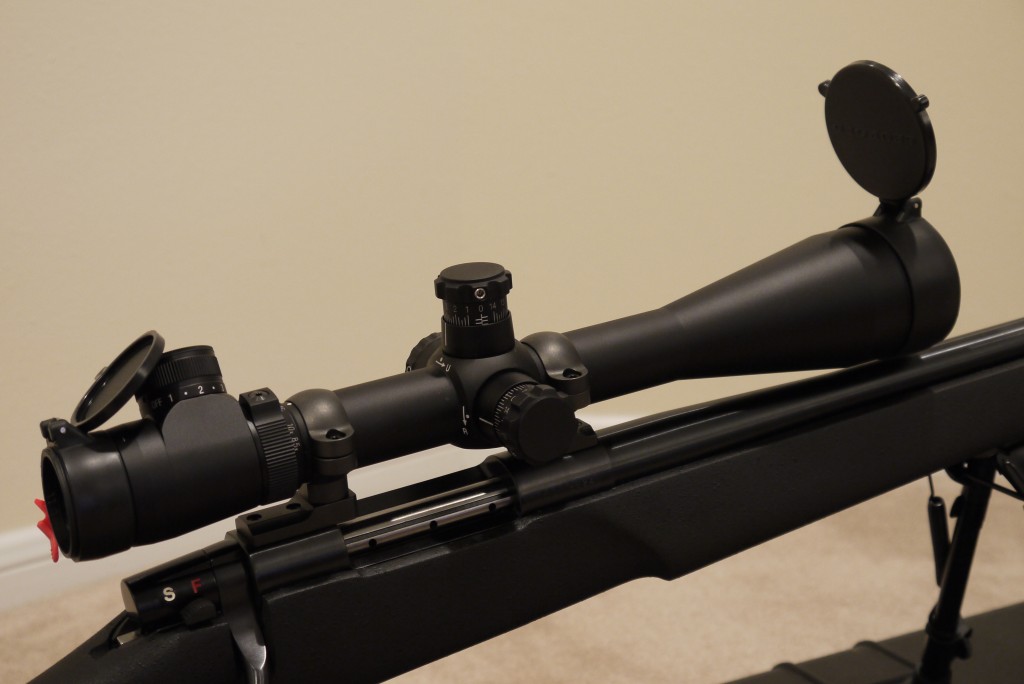
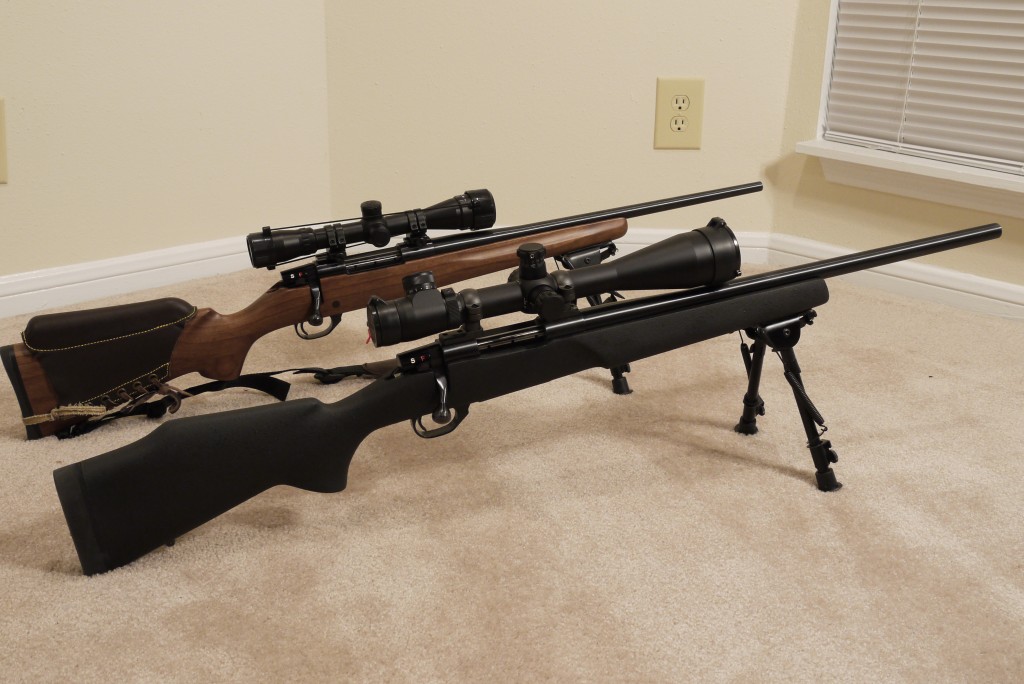
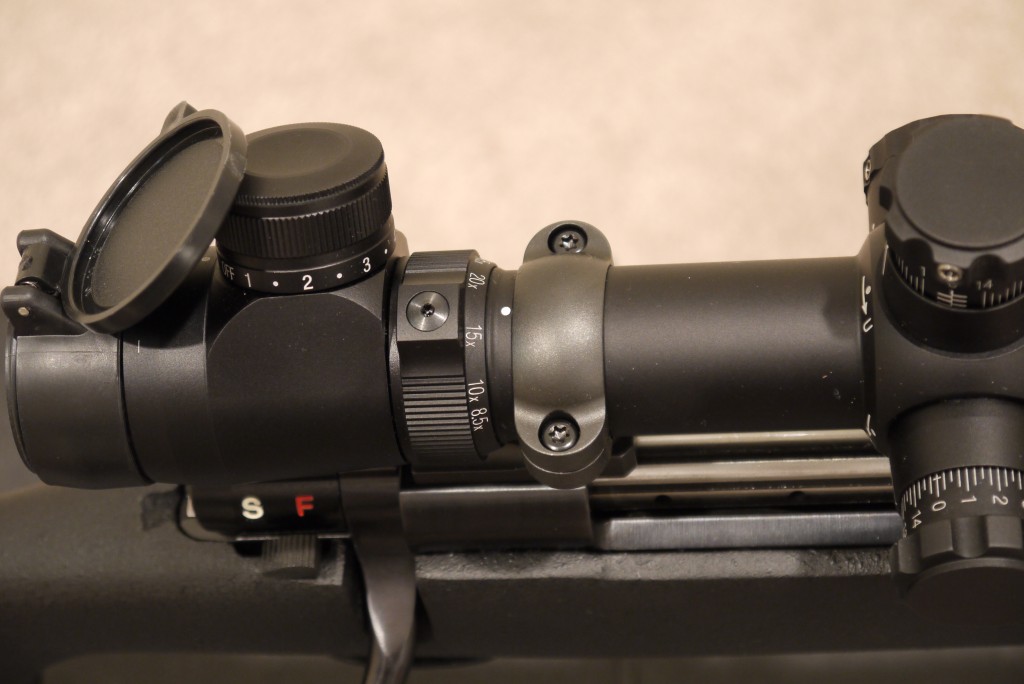
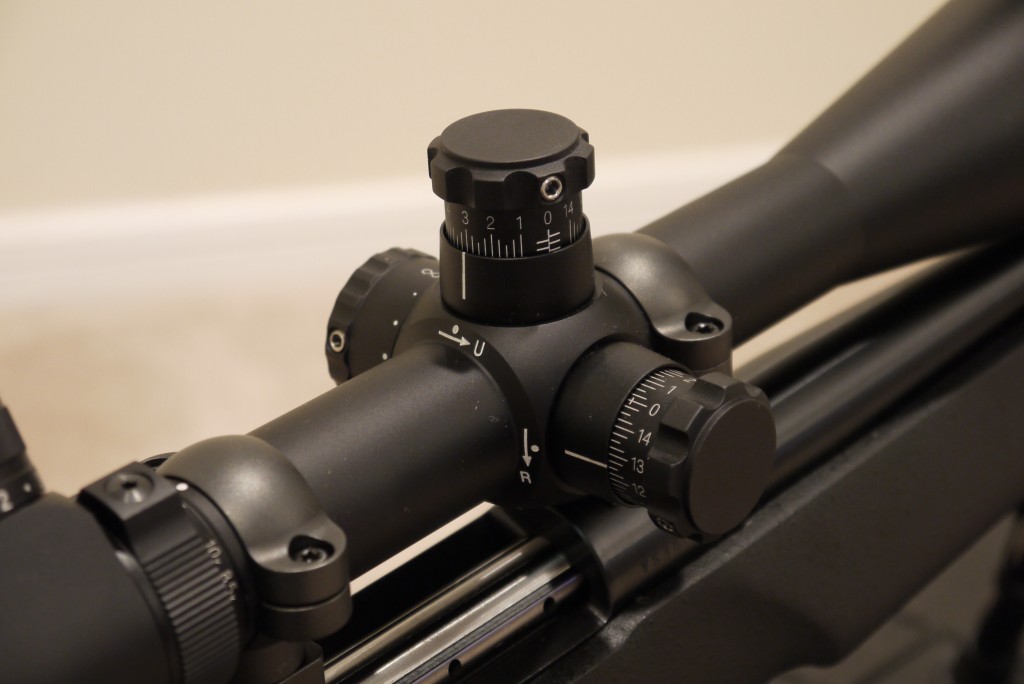
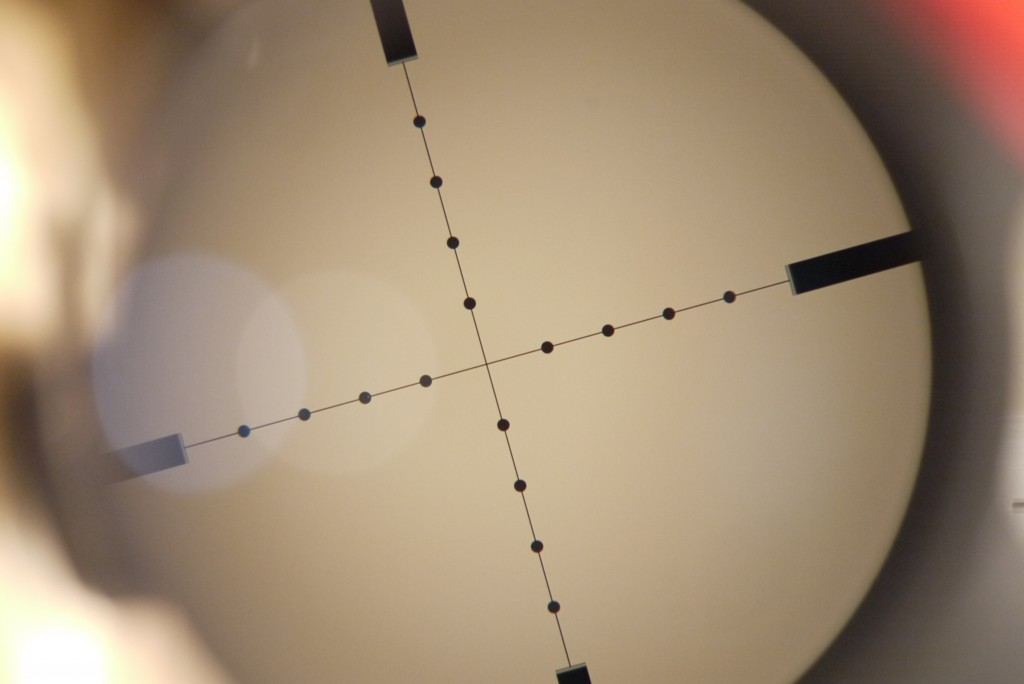
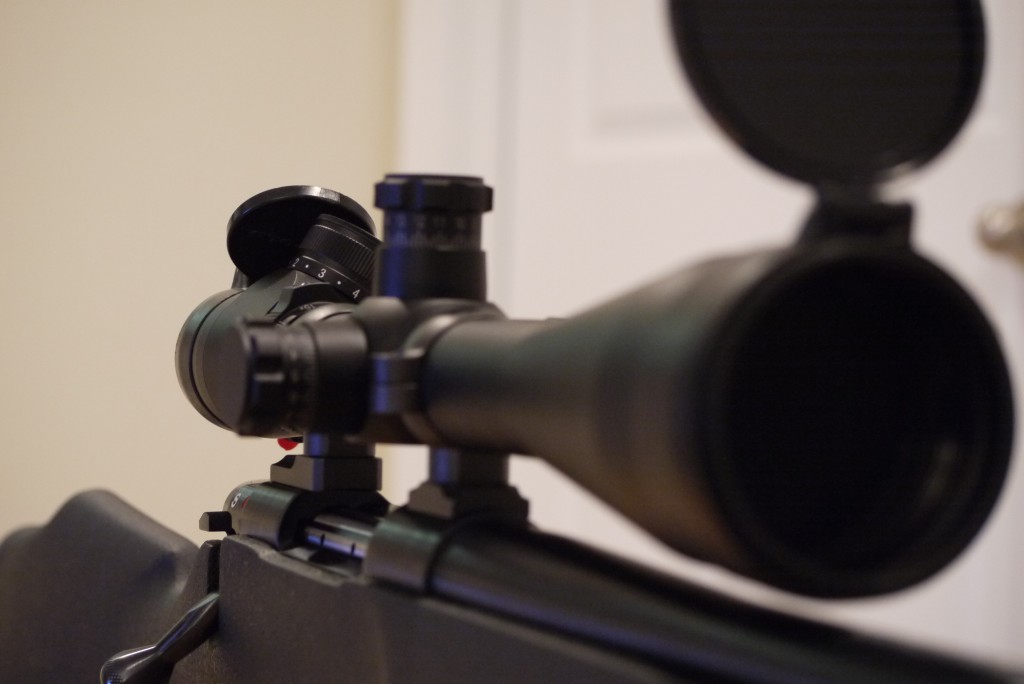



“In an ideal world you should be able to look down the scope, count the distance between POI and POA using the markings, and adjust accordingly.”
This is not what Mil-Dot reticle is for. It is designed to be used for range estimation and hold over, not for making sighting in at the range easier. But if you’re using it for that, it’s easy to remember that there are approximately 14 clicks in one MIL for a typical scope with 1/4 MOA clicks. No calculator needed.
“That’s not even touching the fact that the MIL dots aren’t the “typical” setup. A typical MIL dot setup will have the dots themselves be 1 MIL tall by 1 MIL wide spaced 1 MIL apart from each other”.
Uh, no. A typical size of a dot is 0.2 MIL, and this is what Leupold is using. A reticle with dots sized at 1 MIL would be unusable.
And there I go misreading the spec again.
Updated, fixed, thanks.
Leupold Mark 4 3.5-10 X 40 is my scope and Ditto. Great article.
To follow on from Lord Cthulhu’s post, the reticle has to be in the second focal plane in order to use it for range finding, right? Otherwise it would scale with the target and would be useless for that application.
Aren’t mil-dot and second focal plane reticle completely complimentary?
Given that, should you amend your review?
The entire idea behind a range estimating scope is that the range estimation dealie on the reticle is a fixed and known interval. If the size changed relative to the target then you couldn’t use it properly. The scope I linked to at the end of the article uses a first focal plane reticle and is much better for range estimation.
From Cheaper Than Dirt: “Variable magnification scopes come in two types: First Focal Plane (FFP) or Second Focal Plane (SFP) reticles. Most American scopes have the reticle on the second or rear focal plane, so that the reticle stays the same size as the zoom is changed. European style scopes have the reticle on the first or front focal plane, such that as the magnification on the scope is increased the reticle increases in size. European Mil-Dot reticles are accurate for range estimation at any zoom level. For American style rear focal plane reticles on variable magnification scopes, the Mil-Dot size estimation is only accurate at a certain zoom level. For most variable scopes with a second focal plane reticle the proper magnification is 10x, though this does vary depending on the manufacturer. Consult your owner’s manual to determine what zoom level your Mil-Dot reticle is designed for.”
When the reticule is in the second focal plane, it remains a constant apparent size when you increase/decrease the magnification. Since the target gets bigger and the reticule stays the same size, it’s useless for range estimation unless you’re at the one ‘proper’ magnification setting.
I’m currently testing a different Leupold, which I absolutely adore, and its manual states that the reticule only corresponds to its mil-rad hash marks when the magnification us all the way up at 4x; (it’s not a huge scope.)
I am really perplexed that the reticule is marked in mils while the turrets adjust in 1/4 MOA. That might make sight-in easier for the mil-rad illiterate (like me) but it makes it really hard to dial in just the right adjustments.
I guess that I’m missing something. If the reticle is in the first focal plane and gets bigger and smaller with the target, then how do you compare the target against it in order to determine range?
I thought that being in the second plane, the reticle would be sort of fixed. So if the target is far away, it will look small in relation to the reticle and in that way you could
estimate range. But, I must be thinking about this incorrectly.
Think of the reticle as a ruler. I know it’s not a ruler, but humor me and think of it as a ruler.
When you’re closer to the ruler, an inch looks bigger than when you’re further away, but it isn’t. An inch is an inch, no matter what the distance you are from it. So an inch looks smaller at ten feet than it does at, well, at an inch, but everything else looks smaller at ten feet so all is in proportion. With a first focal plane reticle, the ruler and the target stay in exact (okay, near-exact) proportion to each other. An inch stays an inch. That’s good. Capice?In the second focal plane, the correlation twixt target and reticle changes since the magnification of the reticle doesn’t change, and an inch ain’t necessarily an inch no mo’. And that makes things tough sometimes, but not all the time. There is a sweet spot where an inch stays and inch, but at greater or lesser magnifications, an inch can be a half-inch or six inches, and our brain can no longer trust our eyes.
A second focal plane reticle delivers a nice, big one-size fits all crosshair at all magnifications, while an FFP reticle delivers a proportional crosshair. Both are good, and both are trade-offs.
What he said.
Ralph, good explanation. Nicely done.
A high compliment indeed, coming from the master at making the complex understandable.
Agreed, well done with the ruler comment. Another something most of us can relate to…. Have you ever put a mountain or someone’s head between your thumb and index finger and squished it? Even if you do that with someone’s head at let’s say 6 feet away…when your fngers are close to your eye the person’s head fits between your finger and thumb. As you move your hand away from your eye and closer to the head (zooming in on target), you have to increase the distance between your finger and thumb to make the head “fit” between yout fingers. Go ahead try it…. thats the basic concept with first focal point. hope this helps some one out there.
Ralph, Nick
Thanks, I think that I’m with you in what you said. But, what about range estimation? I take range estimation to be, well, trying to figure out how far away something is.
Say a deer is 100 yards away and you focus your second-optical-plane scope in on him. The reticle will be at some proportion to the deer.
Now, say the deer is 500 yards away and you again focus the same scope. From what I understand you saying, the reticle will be in the same proportion to the deer as it was at 100 yards.
If I showed you both sight pictures without telling you the range, could you estimate range from this information?
Now, what if at 500 yards the scale between the reticle and deer was different than what it was at 100. Could you not then use that info to estimate range?
Thanks,
Jason
Jason,
You’re ALMOST there, let me see if I can get you to the finish line.
Range estimation works by comparing a segment of the reticle that you absolutely 100% know is 1 MIL to an object you kinda know how big it is (say, an average human).
This is where that “first focal plane” reticle comes in handy, because no matter what magnification you’re using the MILs will be the same size compared to the target (if you zoom in and out). If the target itself moves forwards or backwards it will appear to get “bigger” or “smaller” compared to the MIL dots. The fact that the target gets bigger compared ot the MIL dots when it gets closer means we can estimate the range if we know how big the target actually is.
The formula for estimating range to the target (in yards) is [(target height in inches X 27.8)/(Height in Mils)]. So if a 60 inch tall human appears to be 2 MILs tall then he’s 834 yards away. Approximately. If the target moves closer and is now 3 MILs tall (because targets appear to grow compared to the fixed MILs when they get closer), he would be 556 yards away.
Gimme a few days and I’ll piece together an Ask Foghorn article about range estimation complete with diagrams and such, but for the moment does that make sense?
Yes, that makes sense, the ratio of target to MILs is invariant to zoom. If the 60inch human is 2 MILs at 1X zoom, he’s 2 MILs at 25x.I only have a cheap Nikon scope on my rifle so I only have experience with that. On the Nikon, you focus on the reticle. With the reticle in focus, a target about 100 yards away will also be in focus.On these mega range scopes, do they allow independent control of the reticle focus and target? Taking the example of my Nikon, could you push out the point where both reticle and target are both in focus to say 500 yards?Thanks a lot, Jason
Someone is forgeting something, the Illuminated Reticle.
I hate to rain on Foggy’s parade but the scope was not designed with his personal shooting needs in mind.
That scope was engineered in response to the specific needs of a specific type of shooter. As someone who does use an illuminated MD Tacticle zooming scope I can assure him that shooting in low-no light with a non-illuminated reticle is a no go, hence the need for that very feature. Mil. to MOA is a far easier feat to accomplish than the anguish inked on these pages would lead one to believe.
The review showed much personal bias and little personal field experience with the item discussed.
Yeah everyone who complained about the scope being in Mils and not in MOA hasn’t done their math correctly. The reviewer doesn’t have much practical hunting or long range experience it seems like.
Man, I thought my VX-I 2-7×32 was fancy!
The scope seems to be nice, but I think there is way too much personal bias by an inexperienced shooter. This scope was not designed to punch holes in paper targets at a range. This scope is for people who have been trained to read the mils and and plug that reading into the MOA formula to adjust your POI.
“Like minutes of angle (MoA), milliradians provide a method of identifying and quantifying the angle made by the point of impact (POI) relative to the point of aim (POA) of the scope. Or something like that.” -Leghorn
No nothing like that. The Mils serve as a fixed reference point to measure the target against to provide the shooter with an accurate range. However to use the mil dots effectively you have to know the size of the object you are measuring. Once you have an accurate range you can also use the mil dots to measure the wind value, the targets speed (if its moving) and other useful data. Once you have all of that data you plug it into the calculator and it gives your MOA adjustments on your scope. It is a lot of math. (Some Basic Trig, Geometry, and Calculus) but if you know what your doing you can get on target every time.
As for the First Plane VS Second Plane. I prefer the Second Plane scopes myself. I lower the scope to the correct magnification, take a measurement, adjust the scope and then zoom in for the shot. I learned on an old Second Plane scope my uncle had, and he taught me in high school how to do the calculations after I missed my first shot on a white tail because I just estimated everything an didn’t account for the bullets trajectory at over 300 yards.
If you never plan on taking your rifle past the 300 yard marker, and you don’t plan on shooting in low light conditions, and you always know your targets distance than this glass isn’t for you.
“I’ve seen people hit the 10 ring from 1,000 yards away using nothing but a M-16 with aperture sights”
Wait, really? The 55gr bullet lost supersonic at about 600…
I bet he meant a M14???LOL
For being a scope designed for long range shooting, the reviewer said next to nothing that would be useful to anyone wanting to know about how it performs for accurate long range shooting, or how it compares to similar scopes from other manufacturers in the field.
Writing about a tactical scope and saying it weighs more than my 3-9×40, $200 hunting scope doesn’t really provide any useful information. It’s comparing apples to oranges.
My uncle has this exact scope. He has it on his .308 remington. He was hitting such a good group at 763 yards away that the holes were touching. The scope is a champ, honestly for the money you couldn’t go wrong. The scope will do almost anything you want. My cousin also has the luepold mark 4 on his .243 remington model seven hundred. We can snipe crows out of our field sitting 500-600 yards away.